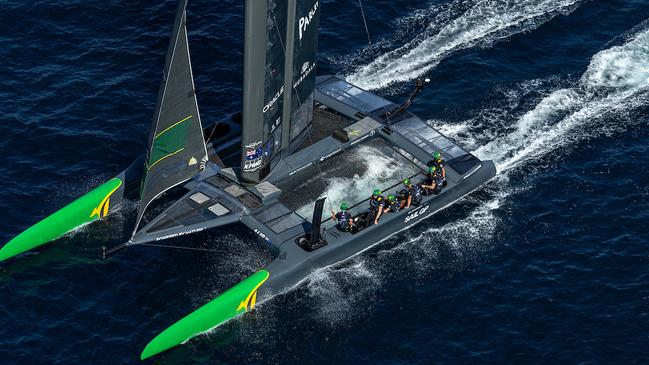Sail GP Sydney: Australian Tom Slingsby out to break 100km/h speed barrier on Sydney Harbour
It’s proven as elusive as a win for the Australian SailGP team this season – cracking the 100km/h speed barrier. But skipper Tom Slingsby has his eye on a wild new record on Sydney Harbour
Local Sport
Don't miss out on the headlines from Local Sport. Followed categories will be added to My News.
Tom Slingsby knows that in the search for extreme speed a moment of ecstasy can come with more than a splash of agony – and expensive and extensive repairs.
The Australian skipper is aware one tiny push too far and the thrill of cracking the 100km/h barrier will end in tears and potentially one of the highest damage bills seen in the sport.
But that won’t stop the daredevil Olympian and multiple world sailor of the year and his crew pushing the limits on home waters this weekend in the two days of wild SailGP racing.
Last year the crazy happened on shore when a wild storm thundered in from the west, causing widespread havoc and damage to the wing sails of boats lifted from the water onto shore post racing.
This year, with the potential for strong winds, it could happen on the water.
And while it could be an uncomfortable, physical and jarring ride, Slingsby’s all in as he chases the mantle of SailsGP top gun – and an all-important first leg win in the current series for Australia.

Slingsby said the top speed he and his Australian team have hit in the foiling machines racing in Sydney on Saturday and Sunday afternoon is 92.37km/h.
All-time top speed on the sophisticated F50 catamarans, which race above the water on aerodynamic blades, is 99.94km/h, with this time held by the French crew in 20 knots plus winds in San Tropez.
Slingsby believes Sydney’s conditions could produce the right mix of conditions required to turn the harbour into a record-breaking speedway.
But it will be a rough and dangerous ride with a catastrophic high speed crash a potential by-product of the speed chase.

“Obviously we’re hitting cavitation at those speeds,” said Slingsby, referring to the phenomenon where high-speed causes the water to bubble near the foil, reduces lift and ultimately limits the ability to fly the boat.
“And if you do touch 100 now, it’s going to be shortly followed by a crash because you lose all lift on the foils at those speeds.
“It’s a good and bad thing, getting those sorts of speeds.
“If you do 100, just with the cavitation on these foils and everything, it will be followed by a pretty significant crash straight after. So it’s also daunting.
“So you just want to just get over that 100km/h mark and then back off pretty quickly.’’

Like off-road driving, cavitation makes for a tough, rugged and bumpy ride. As the F50 slows, its platform shudders and shakes as the foil struggles to generate lift from the vaporised water surrounding it.
“On the wheel there’s a lot of load and yeah, I’m a 90 kilo pretty fit guy and I’ve got to hold the wheel as tight as I can because it’s really bucking you around quite a lot,’’ Slingsby said.
But even the prospect of a major crash won’t deter these sailing speed junkies from their quest.
“For sure we will go for it,” Slingsby said. “Everyone wants to crack the 100.
“We’re just right on the limit of what sailing boats can do speed wise but you still want to do it.
“It’s also the most exhilarating thing you can do because you know you’re right on the edge of a crash.
“These foils are essentially like an aeroplane wing and you need them full control over them to control your flight.
“The way it feel is like turbulence on an aeroplane. Then it starts pumping in and then all of a sudden you start adding lift and the lift isn’t coming and it become very erratic, and yeah, it’s a bit scary because you just don’t know what’s going to happen.
“You don’t know the foil is going to lift you or if its going to suck you down into the water.”
The SailGP series has been raced on Sydney Harbour every year since its inception four seasons ago.
This year the fleet boasts 10 teams with the Australians hunting their first leg win of the season.
SAILGP SYDNEY: WHAT YOU NEED TO KNOW
The machines raced are superfast hydro foiling F50 catamarans.
These crazy cats fly at extraordinary speeds close to 100km/h.
Each F50 is crewed by six sailors. The Australian team for the Sydney event is made up of skipper and driver Tom Slingsby, flight controller Jason Waterhouse who maintains the elevation of the boat on the foils, Kyle Langford who is the wing trimmer and manages the wings, grinders Sam Newtown and Kinley Fowler who help power the trimming of the wing and strategist Natasha Bryant.
Sydney is the eighth event of the fourth season of the lucrative professional sailing series.
The 13-event season concludes with a winner-take-all grand final in San Francisco later this year.
At each SailGP there are six fleet races before the top three advance into a one-race final.
This will determine the leg winner and the places for the event.
Races have a 16 minute cut off. However, these races can count as long as one team has reached the third gate before the race is stopped.
In Sydney, the racing will take place from 4pm on Saturday and Sunday and will be contested by 10 teams – Australia, Canada, Great Britain, France, Germany, New Zealand, Denmark, Spain, Switzerland and the US. Australian sailors have a presence in most crews.
Tom Slingsby and the Australian team lead the pointscore overall going into their home event with 56 points and ahead of New Zealand (50) and the United States (43).
New Zealand won the last event to cut Australia’s championship lead to six points but at this event the Australians suffered a major technical issue which impacted their result.
More from AMANDA LULHAM HERE





